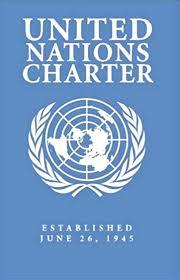Editing office - New York
 Peace, dignity and equalityon a healthy planetUN CharterUN CharterPreambleChapter I: Purposes and Principles (Articles 1-2)Chapter II: Membership (Articles 3-6)Chapter III: Organs (Articles 7-8)Chapter IV: The General Assembly (Articles 9-22)Chapter V: The Security Council (Articles 23-32)Chapter VI: Pacific Settlement of Disputes (Articles 33-38)Chapter VII: Action with Respect to Threats to the Peace, Breaches of the Peace, and Acts of Aggression (Articles 39-51)Chapter VIII: Regional Arrangements (Articles 52-54)Chapter IX: International Economic and Social Cooperation (Articles 55-60)Chapter X: The Economic and Social Council (Articles 61-72)Chapter XI: Declaration Regarding Non-Self-Governing Territories (Articles 73-74)Chapter XII: International Trusteeship System (Articles 75-85)Chapter XIII: The Trusteeship Council (Articles 86-91)Chapter XIV: The International Court of Justice (Articles 92-96)Chapter XV: The Secretariat (Articles 97-101)Chapter XVI: Miscellaneous Provisions (Articles 102-105)Chapter XVII: Transitional Security Arrangements (Articles 106-107)Chapter XVIII: Amendments (Articles 108-109)Chapter XIX: Ratification and Signature (Articles 110-111)Amendments to Articles 23, 27, 61, 109 United Nations CharterThe Charter of the United Nations is the founding document of the United Nations. It was signed on 26 June 1945, in San Francisco, at the conclusion of the United Nations Conference on International Organization, and came into force on 24 October 1945.The United Nations can take action on a wide variety of issues due to its unique international character and the powers vested in its Charter, which is considered an international treaty. As such, the UN Charter is an instrument of international law, and UN Member States are bound by it. The UN Charter codifies the major principles of international relations, from sovereign equality of States to the prohibition of the use of force in international relations.Since the UN's founding in 1945, the mission and work of the Organization have been guided by the purposes and principles contained in its founding Charter, which has been amended three times in 1963, 1965, and 1973.The International Court of Justice, the principal judicial organ of the United Nations, functions in accordance with the Statute of the International Court of Justice, which is annexed to the UN Charter, and forms an integral part of it. (See Chapter XIV, Article 92)
Peace, dignity and equalityon a healthy planetUN CharterUN CharterPreambleChapter I: Purposes and Principles (Articles 1-2)Chapter II: Membership (Articles 3-6)Chapter III: Organs (Articles 7-8)Chapter IV: The General Assembly (Articles 9-22)Chapter V: The Security Council (Articles 23-32)Chapter VI: Pacific Settlement of Disputes (Articles 33-38)Chapter VII: Action with Respect to Threats to the Peace, Breaches of the Peace, and Acts of Aggression (Articles 39-51)Chapter VIII: Regional Arrangements (Articles 52-54)Chapter IX: International Economic and Social Cooperation (Articles 55-60)Chapter X: The Economic and Social Council (Articles 61-72)Chapter XI: Declaration Regarding Non-Self-Governing Territories (Articles 73-74)Chapter XII: International Trusteeship System (Articles 75-85)Chapter XIII: The Trusteeship Council (Articles 86-91)Chapter XIV: The International Court of Justice (Articles 92-96)Chapter XV: The Secretariat (Articles 97-101)Chapter XVI: Miscellaneous Provisions (Articles 102-105)Chapter XVII: Transitional Security Arrangements (Articles 106-107)Chapter XVIII: Amendments (Articles 108-109)Chapter XIX: Ratification and Signature (Articles 110-111)Amendments to Articles 23, 27, 61, 109 United Nations CharterThe Charter of the United Nations is the founding document of the United Nations. It was signed on 26 June 1945, in San Francisco, at the conclusion of the United Nations Conference on International Organization, and came into force on 24 October 1945.The United Nations can take action on a wide variety of issues due to its unique international character and the powers vested in its Charter, which is considered an international treaty. As such, the UN Charter is an instrument of international law, and UN Member States are bound by it. The UN Charter codifies the major principles of international relations, from sovereign equality of States to the prohibition of the use of force in international relations.Since the UN's founding in 1945, the mission and work of the Organization have been guided by the purposes and principles contained in its founding Charter, which has been amended three times in 1963, 1965, and 1973.The International Court of Justice, the principal judicial organ of the United Nations, functions in accordance with the Statute of the International Court of Justice, which is annexed to the UN Charter, and forms an integral part of it. (See Chapter XIV, Article 92)